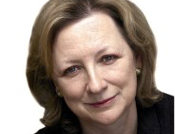Spectator - Carla Carlisle
Lent is not only a time of denial but contemplation. Carla Carlisle's one Lenten slip is the purchase of a picture that speaks to her of the beauty and fragility of a world dominated by human activity:The Last Iceberg.


A close friend says that being in Alcoholics Anonymous is like observing Lent all year round: denial, meditation, confession, repentance. She tells me this because, each year, I think about giving up wine for Lent, but never do. She, who has given up wine for life, believes that denial needs a framework. 'Like Lenten complines, an evening a week with others. Otherwise sacrifice gets lost in private dailyness.' This year, I embarked on an equally difficult programme of denial, a vow not to buy anything unnecessary. Not the flowery linen skirt that spoke to me of spring, nor the divine taupe shoes. Not even the tempting catalogue to the Americans in Paris exhibition.
As Lent was originally only three days, I gave myself a mid-way reprieve during our few days in Scotland the pay off to a promise we'd made to Sam: do well in your GCSEs, and two-days' fishing on the Tay will be yours. And my reward: a pilgrimage to the Watermill in Aberfeldy, the bookshop/gallery/music-and-coffee shop that is my personal Compostela. I negotiated my slot of time at the Watermill as carefully as Sam organised his ghillie, and I arrived at the same pitch of excitement that he feels on a salmon river.
But before I reached the shelves, I saw a notice for the exhibition in the gallery on the top floor of the bookshop. 'Ice and Light: Antarctica'. My heart stopped. My fascination for Antarctica began on Putney Heath. For four years, I lived in a first-floor flat at 7, Heathview Gardens. Although no blue plaque identified the house, this was the London home of Ernest Shackleton, and the week I moved in (December 1981), a snow storm transformed the Heath into a polar wonderland.
My neighbour, a mountaineering lawyer named John Harding, loaned me his copy of South, Shackleton's account of his crew's struggle for survival after their ship was crushed, leaving them stranded on ice floes in the Weddell Sea. Although I knew the harrowing stories of Scott's expedition, I'd barely heard of Shackleton. After reading South, I tracked down everything I could find about Scott, Oates, Shackleton and Frank Hurley, whose photographs and diary of Shackleton's 1914 voyage to Antarctica are the most beautiful and haunting images in my mind's visual museum. Until, that is, I stood in the small gallery in Aberfeldy and looked at the paintings by Malize McBride.
The artist's fascination with Antarctica began with her father's copy of Apsley Cherry-Garrard's book The Worst Journey in the World, the indescribably sad account by the youngest member on Scott's journey to the South Pole. That book was the beginning of a longing to see Antarctica, a desire weighed down by guilt: the pressure on that fragile environment from tourism is huge. Only when McBride was reassured by the severe limits on access, did she go there herself in January 2004.
I arrived on the last day of the exhibition. A few pictures were unsold, including the largest, some 8ft wide, called Last Iceberg. Majestic, silent, contemplative, it spoke of those explorers; brave, optimistic, bookish men, eating stewed penguin and reading Tennyson. And, inevitably, of how the well-being of our planet depends on these skyscrapers of ice. In a few days, Last Iceberg will hang in my house. Not in keeping with vows, but a Lenten meditation on what the men who encountered these ice mountains knew: Fortune gives us nothing which we can really own.
This article first appeared in Country Life magazine on April 13, 2006.
Sign up for the Country Life Newsletter
Exquisite houses, the beauty of Nature, and how to get the most from your life, straight to your inbox.
Country Life is unlike any other magazine: the only glossy weekly on the newsstand and the only magazine that has been guest-edited by HRH The King not once, but twice. It is a celebration of modern rural life and all its diverse joys and pleasures — that was first published in Queen Victoria's Diamond Jubilee year. Our eclectic mixture of witty and informative content — from the most up-to-date property news and commentary and a coveted glimpse inside some of the UK's best houses and gardens, to gardening, the arts and interior design, written by experts in their field — still cannot be found in print or online, anywhere else.
-
 Six rural properties with space, charm and endless views, as seen in Country Life
Six rural properties with space, charm and endless views, as seen in Country LifeWe take a look at some of the best houses to come to the market via Country Life in the past week.
By Toby Keel
-
 Exploring the countryside is essential for our wellbeing, but Right to Roam is going backwards
Exploring the countryside is essential for our wellbeing, but Right to Roam is going backwardsCampaigners in England often point to Scotland as an example of how brilliantly Right to Roam works, but it's not all it's cracked up to be, says Patrick Galbraith.
By Patrick Galbraith